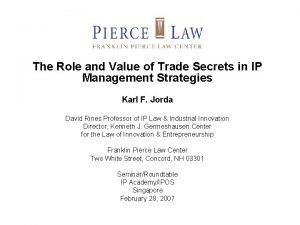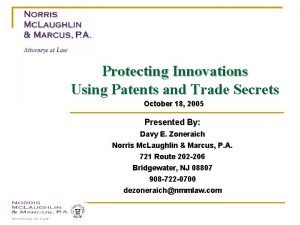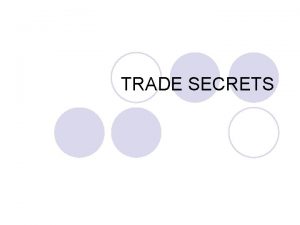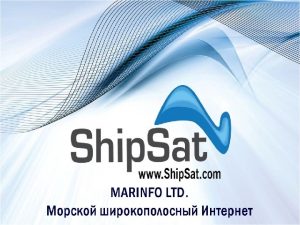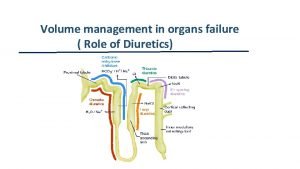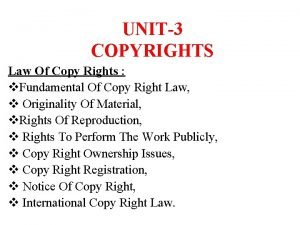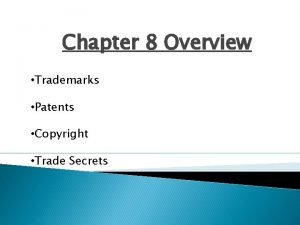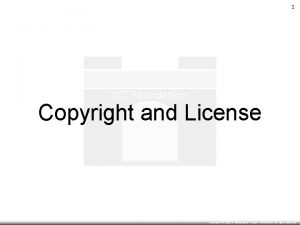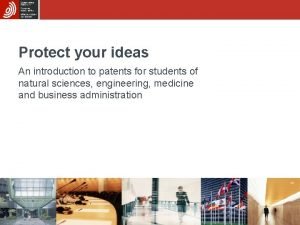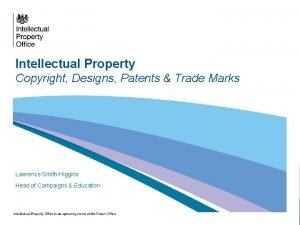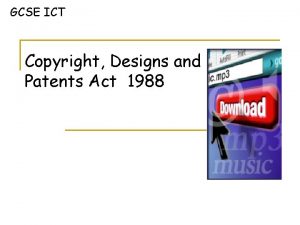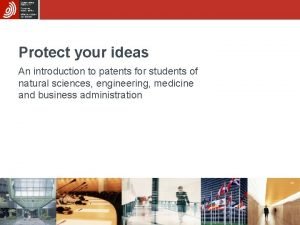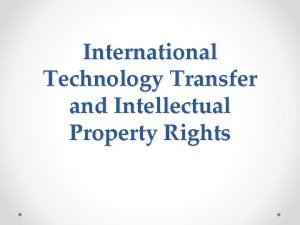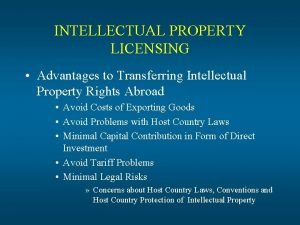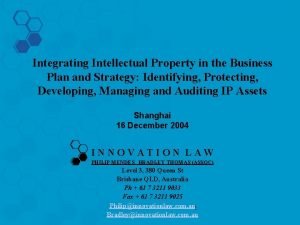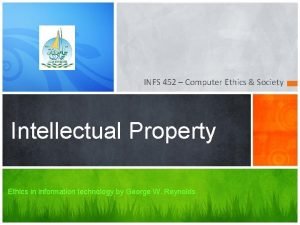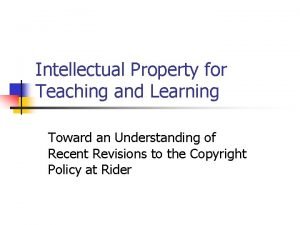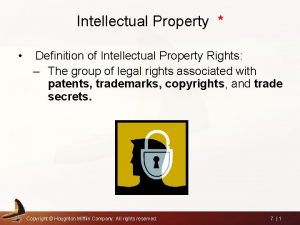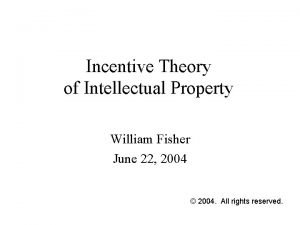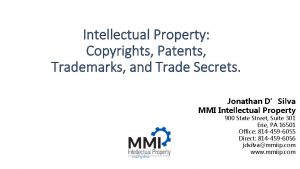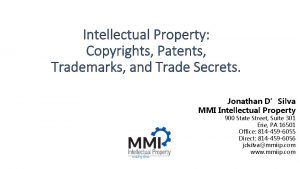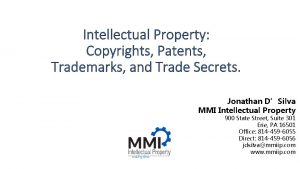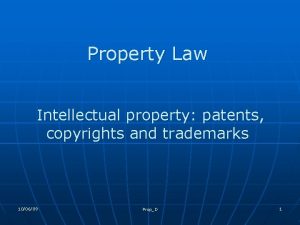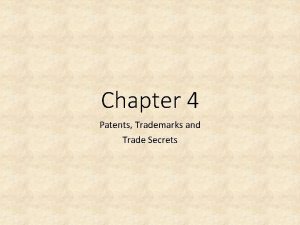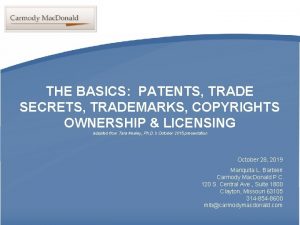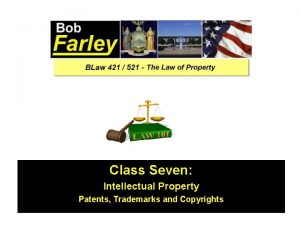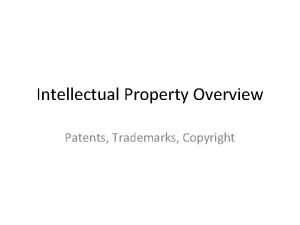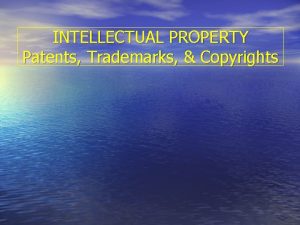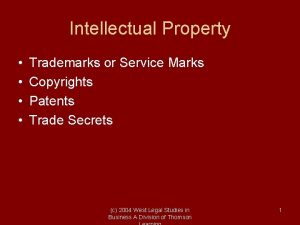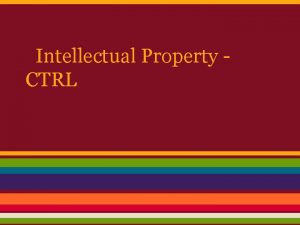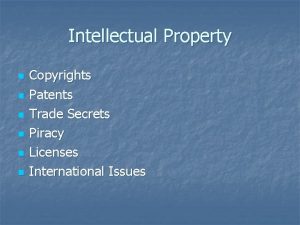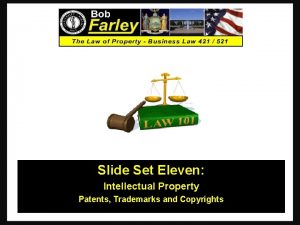Intellectual Property Copyrights Patents Trademarks and Trade Secrets






















- Slides: 22

Intellectual Property: Copyrights, Patents, Trademarks, and Trade Secrets. Jonathan D’Silva MMI Intellectual Property 900 State Street, Suite 301 Erie, PA 16501 Office: 814 -459 -6055 Direct: 814 -459 -6056 jdsilva@mmiip. com www. mmiip. com

Copyright Notice Copyright © 2017 D’Silva Law Group, PLLC All Rights Reserved All materials contained herein are protected by United States copyright law and may not be reproduced, distributed, transmitted, displayed, published, or broadcast without the prior written permission of D’Silva Law Group, PLLC, d. b. a. MMI Intellectual Property. The information contained in this presentation is for informational purposes only. These materials should not be viewed or interpreted as providing legal advice. Please consult an attorney concerning your own situation. Use of this presentation or related content should not be construed as created an attorney-client relationship.

Patents

What is Patentable? • 35 U. S. C. 101 Inventions Patentable • "Whoever invents or discovers any new and useful process, machine, manufacture, or composition of matter, or any new and useful improvement thereof, may obtain a patent therefore…"

What is Patentable? • Applied Computer Software • Business Methods • Machinery • Gadgets • Compositions of Matter • Methods of Using Any of the Above

Requirements for Patentability • Novelty • Must incorporate something new • Utility • No perpetual motion machines • Non-obviousness • Patentable subject matter • "Anything new under the sun" that is made by man • Cannot patent "the laws of nature, physical phenomenon, and abstract ideas" – no equations, no theories • Enablement • Must disclose how to practice the invention

Types of Patents • Utility Patents • "process, machine, manufacture, or composition of matter, or any new and useful improvement thereof" • Design Patents • "new, original, and ornamental design for an article of manufacture" • Plant Patents • "invents or discovers and asexually reproduces any distinct and new variety of plant“ • Provisional Patent • 1 year placeholder for Utility Patent Applications

Patent Terms • Utility and Plant Patents • Prior to June 8, 1995, 17 years from date of grant • After and on June 8, 1995, 20 years from date of filing • Must pay maintenance fees at 3. 5 years, 7. 5 years and 11. 5 years after grant • Design Patents • 15 years from date of grant • No maintenance fees • Provisional Patent • 1 Year from filing

Patent Filing Deadline • For Patents Not Available for International Protection 365 days Date of first: -Offer for sale -Public use -Publication -Public disclosure -Non-confidential written disclosure Deadline to file U. S. patent application

Paris Convention • International patent filings 365 days Date of first U. S. formal or provisional patent application Deadline to file in all foreign patent offices and/or regional patent offices.

Patent Cooperation Treaty (PCT) • For Patents to be Filed in Multiple Countries: 0 12 18 19 30 Months Months 365 Days Date of first U. S. formal or provisional patent application Deadline to file PCT (International) Application gets published International Examination (Ch. II) National Phase Application goes to various national/regional patent offices

Provisional Application • Filed with the USPTO but not examined • Purpose is to establish priority date and conform with international patent practice • Non-provisional (formal) patent application must be filed within 1 year and have at least one common inventor with the provisional application • Allows use of the term "patent pending" on the invention

Provisional Application • Application is kept confidential and never published • Inventor may sell, continue developing, publish, and promote the invention without loss of patent rights; but: • Risk loss of rights if you do not convert the application to a nonprovisional application • Any public disclosure starts the 1 year statutory time bar if nonprovisional application is not filed

Non-provisional Patent Application • Must be a complete application – no new matter may be added later • May claim priority from a provisional patent application, a prior filed non-provisional patent application, or an International Patent Application filed under the PCT • Allows use of the term "patent pending" on the invention • Application is published 18 months after filing unless a nonpublication request is made • May only request non-publication if you waive the right to seek patent protection overseas

Patent Cooperation Treaty (PCT) • Entered into force in 1978. • Currently 148 member countries. • Administered by the International Bureau (IB) of the World Intellectual Property Organization (WIPO) in Geneva.

Patent Cooperation Treaty (PCT) • Does not result in a patent • Allows residents of any signatory state to file patent applications that will have effect in multiple states. • Gives applicants 30 months (from priority date) to decide whether to file patent applications in other countries.

Patent Costs • Prepare Application: $5, 000 - $50, 000+ • Search Prior Art: $800 - $2, 500 • Analyze Prior Art: $500 - $1, 500+ • Filing Fees at USPTO: $1, 600 - $2, 500+ • Filing Fees for PCT: $3, 750 - $5, 000+ • Respond to Office Actions: varies • Issue Fee: $960 • Maintenance Fees (US): $1, 600/$3, 600/$7, 400

Infringement • Must show that every element of the claims is infringed. • Recovery: Lost Profits, Reasonable Royalty, Triple Damages, Injunction, Attorneys Fees. • National scope: No infringement for activity outside of the country of the patent. • Suit must be filed within six years of infringement.

Defenses to Infringement • Prior Use • Invalid Patent • Previously unknown prior art • Mistake at the Patent Office • Improper Inventorship • No Actual Infringement

Joint Ownership • Multiple owners may jointly own a patent. • Each owner is a full owner of the patent rights. • Make, Use, Offer to sell, Sell, and Import the patented invention. • No consent or accountability needed. • Owners may dispose of their interest independent of the other owners. • Ownership agreements must be recorded with the patent office within three months from date of agreement.

Benefits of Patents • Patent owner may prevent others from making, using, selling, offering to sell invention for the life of the patent. • Helps to keep competitors out of the market. • Licensing opportunities. • Marketing opportunities. • Most companies avoid infringement.

Risks of Patents • Expensive to obtain • Expensive to enforce through litigation (corollary: threatening litigation can be effective) • No guarantee of success • Prosecution risk • Enforcement risk
 Trade related aspects of intellectual property rights
Trade related aspects of intellectual property rights Trade secrets examples
Trade secrets examples Trade secrets examples
Trade secrets examples Trade secrets outline
Trade secrets outline Definition of trade secrets
Definition of trade secrets Image copyrights
Image copyrights Copyrights
Copyrights Copyrights
Copyrights Copyrights
Copyrights Copyrights
Copyrights Advantages and disadvantages of patents
Advantages and disadvantages of patents What is the copyright designs and patents act 1988
What is the copyright designs and patents act 1988 Copyright in ict
Copyright in ict Advantages and disadvantages of patents
Advantages and disadvantages of patents Intellectual property rights in professional practices
Intellectual property rights in professional practices Importance of intellectual property
Importance of intellectual property Intellectual property management definition
Intellectual property management definition Advantages of intellectual property
Advantages of intellectual property Intellectual property in business plan
Intellectual property in business plan Property
Property Right to intellectual property of teachers
Right to intellectual property of teachers Definition of ipr
Definition of ipr Incentive theory
Incentive theory

